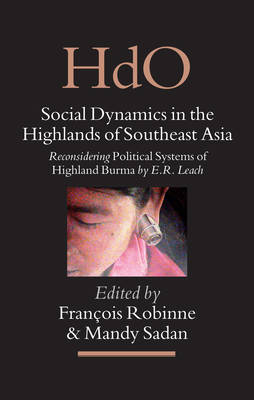
- Afhalen na 1 uur in een winkel met voorraad
- Gratis thuislevering in België vanaf € 30
- Ruim aanbod met 7 miljoen producten
- Afhalen na 1 uur in een winkel met voorraad
- Gratis thuislevering in België vanaf € 30
- Ruim aanbod met 7 miljoen producten
Zoeken
Social Dynamics in the Highlands of Southeast Asia
Reconsidering Political Systems of Highland Burma by E.R. Leach
€ 256,45
+ 512 punten
Omschrijving
This reappraisal of Political Systems of Highland Burma, the seminal work by E.R. Leach, presents much new material on the highlands of Southeast Asia and its borders from writers with long-term research experience in these areas. The Introduction establishes in detail both the theoretical and regional ethnographic significance of Leach's work and the chapters to follow. Part One discusses issues relating to Leach's fieldwork, including the background to his research and issues arising from his fieldwork practice. Part Two presents a variety of engagements with Leach's theoretical approach, particularly his ideas of socio-political oscillation. This theory is considered in relation to the historical experience of culture contact in Assam and Laos, particularly between Tai and non-Tai groups. Part Three considers once more Leach's ideas with respect to communities that are, or could be considered, Kachin sub-groups in Burma, Tibet and Yunnan, this time focusing on interpretations of exchange and the notion of ritual language. A discussion of approaches towards the study of transethnicity concludes the work. The book is a significant contribution to the development of a new regional anthropology of Southeast Asia, incorporating material from areas that were, until recently, closed to researchers.
Specificaties
Betrokkenen
- Uitgeverij:
Inhoud
- Aantal bladzijden:
- 370
- Taal:
- Engels
- Reeks:
- Reeksnummer:
- nr. 18
Eigenschappen
- Productcode (EAN):
- 9789004160347
- Verschijningsdatum:
- 22/06/2007
- Uitvoering:
- Hardcover
- Formaat:
- Genaaid
- Afmetingen:
- 160 mm x 240 mm
- Gewicht:
- 805 g

Alleen bij Standaard Boekhandel
+ 512 punten op je klantenkaart van Standaard Boekhandel
Beoordelingen
We publiceren alleen reviews die voldoen aan de voorwaarden voor reviews. Bekijk onze voorwaarden voor reviews.







